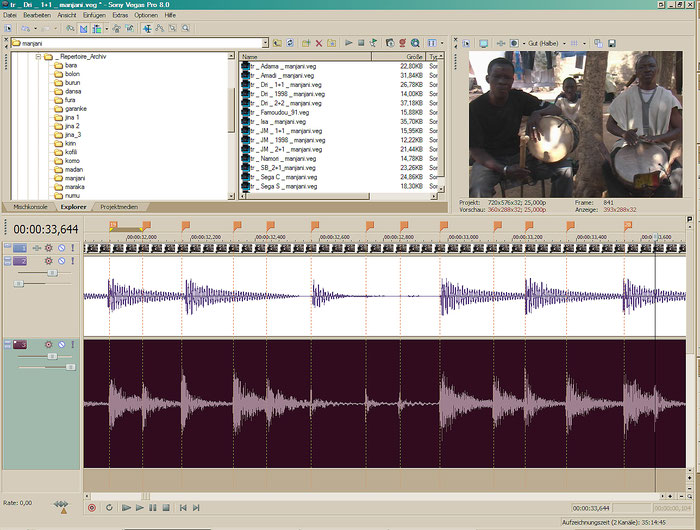Empirical consistency of performance timings
By measuring the intervals between drum-strokes at the millisecond level, I have shown an enormous degree of consistency in the swing timings in three different genres of Malian dance-drumming (Polak 2010; Polak and London 2014; Polak, Jacoby and London 2016). In my ambition to make this line of research increasingly relevant and convincing, I have increasingly profited from the interdisciplinary collaboration with two colleagues, music theorist and cognitive scientist Justin London and cognitive and computational scientist Nori Jacoby. Our collaboration allowed us to compute larger amounts of data and carry out (much) more reliable and sophisticated statistical analyses than I could have done on my own.

Rhythmic Feel as Meter (Polak 2010)
My 2010 paper "Rhythmic feel as meter" (Music Theory Online) documents the
remarkable consistency, down to the millisecond level, for the characteristic rhythms in Manjanin, a standard piece in the repertoire of jembe drumming from Mali. The ternary subdivision of Manjanin's beat occurs in a recurrent pattern of three distinct sizes, short-medium-long, with their ratio gravitating around 25:33:42. While some other pieces, too, show the same or similar subdivision timings, other Malian percussion pieces show different patterns, including both even subdivision, as well as a reversal of the Manjanin pattern. The association of each piece in the Malian repertoire with a specific timing pattern in jembe music is extremely consistent, however.
The paper also looks at the effect of performers (when different groups or individuals play the same piece), performances (different takes of Manjanin played
by the same performers), specific instruments and their roles in the ensemble, the characteristic rhythms of each part, and tempo, as performances of Manjanin always involve a steady and
substantial increase in tempo (sometimes doubling the initial speed of the music by the piece's conclusion). It finds the basic swing timing pattern to be amazingly stable.
Timing and Meter in Mande drumming (Polak and London 2014)
Our 2014 paper "Timing and Meter in Mande drumming from Mali" (again in Music Theory Online), is an extension of Polak 2010. It shows that the sort of rhythmic consistency found in jembe music appears in two other genres of dance-drumming from Mali, too. The latter two genres, Bamana drumming from the Segu region in south-central Mali and Khasonka drumming from the Kayes region in western Mali, are distinct from jembe music in regional/ethnic association, repertoire, style, and instrumentation. Their subdivision timing patterns are identical or similar, however.
The cross-culturally comparative perspective established in this paper allows to conclude that the frequent usage of swing timing patterns in jembe music is not a singular stylistic exception, but a principle that is characteristic of the genre of dance-drumming in Mali (and neighboring countries) in general.
A statistical corpus study (Polak, London, and Jacoby 2016)
The 2016 paper "Both
isochronous and non-isochronous metrical subdivision afford precise and stable ensemble entrainment" compares the rhythmic micro-timings in a corpus of 15 recordings of three pieces of jembe
music. We created onset histograms of all all of the drum-strokes (~40,000 "rhythmic events") of all ensemble parts and all recordings relative to the normalized local beat duration for the three
pieces in the corpus. We replicated in this large data-set what we had shown previously, namely, that the beat subdivision timing ratios consistently gravitate
toward specific values with relatively small standard deviations. We did not stop here, however, with our analysis of the timing data.
If a structurally isochronous pulse would underlie the perception of swung subdivisions, then quasi-isochronous pieces without much flexible deviation should allow for greater precision and stability in rhythm production and ensemble synchronization than music with non-isochronous ("swung") beat subdivisions. However, in our paper we demonstrate that the variability and asynchronies (between ensemble members) found in the swung pieces are not substantially different from isochronous rhythms. Rather, all of the studied jembe ensemble performances emerged to be extremely precise and tightly synchronized. This is inconsistent with the hypothesis that stable swing timing patterns in Malian drumming are perceived as deviations from an underlying isochronous reference pulse.
